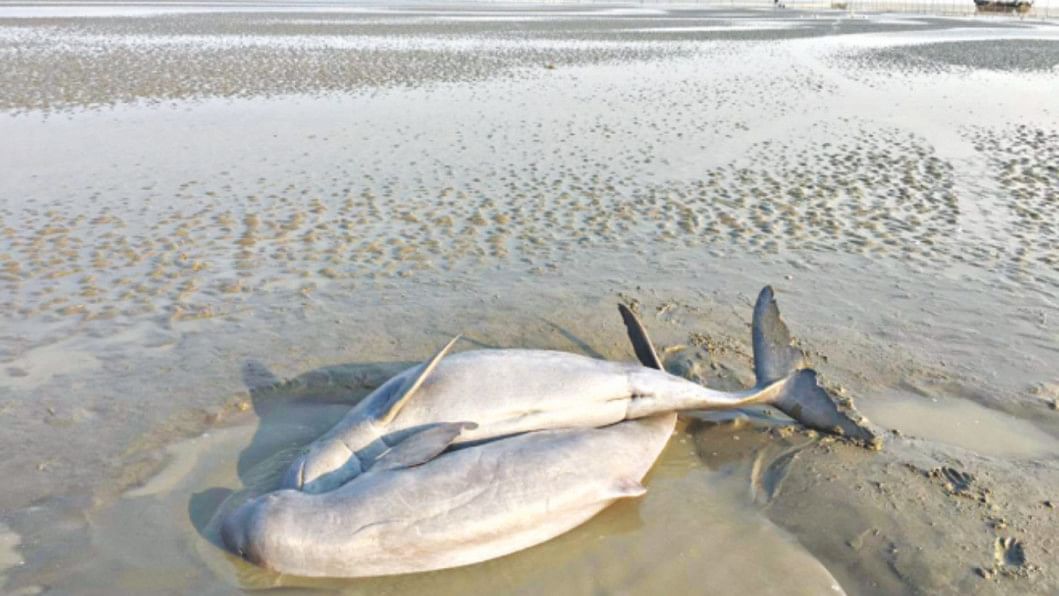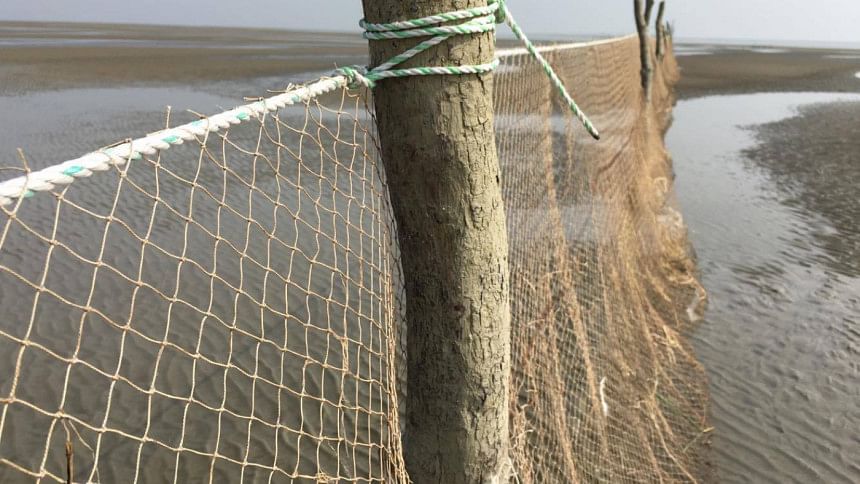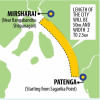Nature Quest: Tale of two stranded dolphins

"A dolphin's smile is the greatest deception. It creates the illusion that they are always happy." Originally stated by dolphin activist Richard O'Barry, these famous lines manage to throw some light on these majestic creatures of the aquatic ecosystem that have enthralled us for long, captivated the human mind and soul, inspired many movies and captured the imagination of children and adults alike.
The joy and sheer magic of watching dolphins jump in and out of the water, frolicking as the tide changes course, that deceptive smile etched on their faces and the mysterious sound of breathing, akin to a shoosh-shoosh or rustling of leaves in a dense forest in the dead of the night -- all lend to their enchanting appeal, especially to the human psyche.
In the fading orange light of dusk on February 5, a team of conservation biologists came across a pair of Irrawaddy dolphins stranded on a shore in Sandwip of Chittagong. The animals were caught in the long shore nets of fishermen there. Watching through their spotting scopes, the surveyors initially thought the fishermen were trying to harm the dolphins.
A one kilometre sprint later, they realised the fishermen were fervently trying to save the pair. Splashing water on their bodies and watching helplessly, the wildlife conservationists found their hearts sinking as they realised they had no idea how to take these heavy animals to the ocean which was now fast receding. The shoreline was at least a kilometre away. It was ebb tide. The sun was setting quickly. The steely horizon, dark and empty for miles held unknown threats. With no cellular network, it was hard to determine the next course of action -- "Do they try to carry the heavy animals to the water?", "Do they continue to splash water on them?"
In that stressful situation, the conservation biologists were left with no choice but to dig a puddle around the dolphins, splash water on their bodies to keep them hydrated, and keep the dolphins' top-side up. The team and the fishermen had to leave as the receding water was taking their boats further and further away. With heavy hearts, the team walked towards their boat now docked almost two kilometres away in the fast diminishing light of dusk, scarred by a sight so profound, it would haunt them for days to come.
The next morning, the surveyors went to the same spot but did not find the dolphins there.
In retrospect, it seems a lot could have been done. However, as mentioned by Elisabeth Fahrni Mansur, director, Training & Education of Wildlife Conservation Society Bangladesh Programme, the circumstances of such stranding were particularly challenging. Faced with a situation such as this, one needs to ensure that the animals are returned to water deep enough, allowing them to swim away. Makeshift stretchers can be made by putting two poles through a lungi or simply by four people holding each corner of the lungi. If the ground is muddy and soft, the animals could also be placed on a cloth and carefully dragged to the water. The body needs to be kept wet and the blowhole (the animal's nostrils on the top of the head through which it breathes) should be kept unobstructed. The animals should always be kept upright without damaging the fins which are very delicate.
Asked whether she thought the Irrawaddy dolphin pair survived, Elisabeth said: "There is no way of knowing if these animals survived or not. Fishermen in Bangladesh generally do not wish to harm dolphins. This incident is important in highlighting the conservation threat that long-shore as well as gill nets directly or indirectly pose for dolphins and many other animals."
The fishermen (in whose long-shore nets the pair of dolphins were caught) said this season five dolphins were caught in their nets and all of them survived. While that makes our hearts soar for the animals that got away, these cases of dolphins being trapped in gill nets or long-shore nets are all too common unfortunately.
"If the animals can't come to the surface to breathe, they drown -- just like us. Our WCS Mortality Monitoring Network receives information on dolphin entanglements and mortalities regularly, mainly through the WCS Dolphin Hotline," says Elisabeth.
In the coastal waters of the Bay of Bengal, entanglements of dolphins, as well as sharks, rays, and marine turtles are very common. Accidentally though, dolphins are frequently caught in the drifting gill nets meant for catching hilsa.

The Irrawaddy and Ganges river dolphins are very special. Bangladesh has comparatively healthy populations of both Irrawaddy and Ganges river dolphins in the Sundarbans waterways -- the only place in the world where they co-exist. These Irrawaddy dolphins are part of the world's largest population of this species right here in our very own coastal and estuarine waterways.
They are top predators, just like tigers in the Sundarbans, and they maintain a healthy ecological balance in the places they live.
"But on top of that, our freshwater dolphins are valuable indicators of ecological changes that are otherwise very difficult to measure. We share so much with these rare and threatened animals - besides being air-breathing mammals that give birth to live babies and feed their young mother's milk, they also depend on sufficient clean water and fish," says Elisabeth.
There is a great opportunity to effectively protect the amazing abundance and diversity of dolphins in Bangladesh.
"Firstly, fishermen and, in general, people in Bangladesh have a positive attitude towards dolphins. For conservationists that's a great advantage. And secondly, the government of Bangladesh through the forest department has shown exemplary leadership in dolphin protection for our region. They have declared crucial dolphin habitats as new sanctuaries in the Sundarbans and declared the country's very first marine protected area. They have been also actively engaged in developing and implementing science-based, community informed management plans for these areas," Elisabeth adds.
Watching dolphins at play, jump out of the water, a smile etched on their face all lend a sense of life and playfulness to the waterways. As Sayam U. Chowdhury, a conservation biologist and nature writer, said in one of his articles: "It seemed as if the rivers breathed through these dark grey creatures and they in turn convey a message of love and perseverance to the river. And when they vanish, the river dies."
Anyone finding a dolphin alive or dead on the beach can call the WCS (Wildlife Conservation Society) Dolphin Hotline (01612228800 or 01713228800) for advice.

 For all latest news, follow The Daily Star's Google News channel.
For all latest news, follow The Daily Star's Google News channel. 








Comments